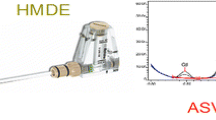Abstract
The chemical composition of microelements in human body is changing due to the global and local anthropogenic stress on biogeochemical cycles. The elemental composition of human hair and the quantitative relationship between the elements serve as summary characteristics of the biogeochemical environmental conditions. Identifying the content of trace elements in the chemical composition of hair requires highly sensitive and selective methods of analysis—electrochemical analysis and, above all, voltammetry. These methods are highly efficient, sensitive, simple, and easily automated. To determine the biogeochemical situation, we examined 180 residents of Tomsk and Seversk and determined the volumes of trace elements in their hair by stripping voltammetry. We found out that the content of trace elements varied significantly, depending on the age and sex of people. Most of the Tomsk population had a deficit of irreplaceable elements (zinc, copper, etc.) in human hair. However, the differences in the content of those elements were statistically significant, which warrants further study on the factors of this variability.
Access this chapter
Tax calculation will be finalised at checkout
Purchases are for personal use only
Similar content being viewed by others
References
Ellison SLR, Williams A (2012) In: Eurachem/CITAC guide: quantifying uncertainty in analytical measurement, 3rd ed. Retrieved from https://www.eurachem.org/
Khlusov I, Slepchenko G, Moiseeva E (2019) An anthropogenic load of copper and somatic health. In: IOP conference series: earth and environmental science, vol 395, pp 012008
Padron P, Paz S, Rubio C, Gutierrez AJ, González-Welle RD, Hardisson A (2020) Trace element levels in vegetable sausages and burgers determined by ICP-OES. Biol Trace Elem Res 194:616–626
Prasad AS (2013) Essential and toxic element: trace elements in human. Health and disease. Elsevier, Amsterdam, Netherlands
Prashanth L, Kattapagari KK, Chitturi RT, Baddam VR, Prasad LK (2015) A review on role of essential trace elements in health and disease. J NTR Univ Health Sc 4:75–85
Taverniers I, De Loose M, Van Bockstaele E (2004) Trends in quality in the analytical laboratory II: analytical method validation and quality assurance. TrAC, Trends Anal Chem 23(8):535–552
Uriu-Adams JY, Keen CL (2005) Copper, oxidative stress, and human health. Mol Aspects Med 26(4–5):268–298
Zaichick V, Zaichick S, Karandashev V, Nosenko S (2009) The effect of age and gender on Al, B, Ba, Ca, Cu, Fe, K, Li, Mg, Mn, Na, P, S, Sr, V and Zn contents in rib bone of healthy humans. Biol Trace Elem Res 129:107–115. https://doi.org/10.1007/s12011-008-8302-9
Acknowledgements
The study was funded by the Competitiveness Enhancement Program grant of the Tomsk Polytechnic University. The study was conducted in the framework of the Government Task “Science (basic),” project No. 20.0025.GZB.2020.
Author information
Authors and Affiliations
Editor information
Editors and Affiliations
Rights and permissions
Copyright information
© 2023 The Author(s), under exclusive license to Springer Nature Switzerland AG
About this chapter
Cite this chapter
Slepchenko, G.B., Khlusov, I.A., Moiseeva, E.S. (2023). Stripping Voltammetry as a Method for Assessing the Possible Effects of Microelements on Humans. In: Maximova, S.G., Raikin, R.I., Chibilev, A.A., Silantyeva, M.M. (eds) Advances in Natural, Human-Made, and Coupled Human-Natural Systems Research. Lecture Notes in Networks and Systems, vol 250. Springer, Cham. https://doi.org/10.1007/978-3-030-78083-8_13
Download citation
DOI: https://doi.org/10.1007/978-3-030-78083-8_13
Published:
Publisher Name: Springer, Cham
Print ISBN: 978-3-030-78082-1
Online ISBN: 978-3-030-78083-8
eBook Packages: Intelligent Technologies and RoboticsIntelligent Technologies and Robotics (R0)



